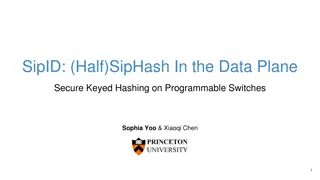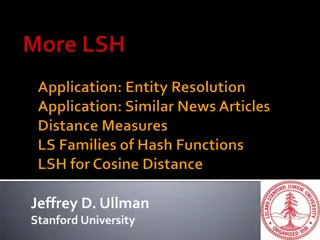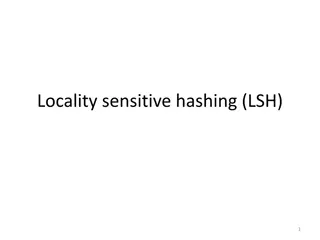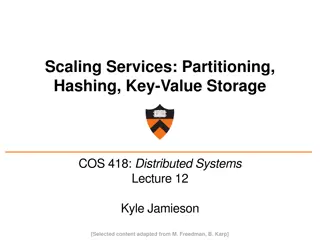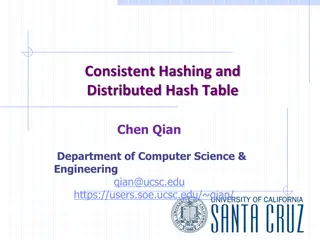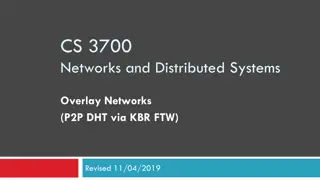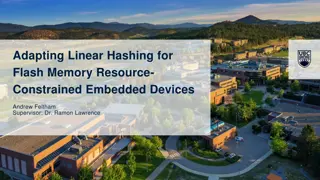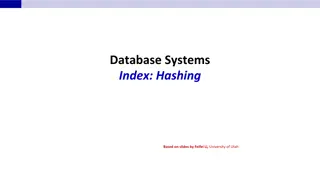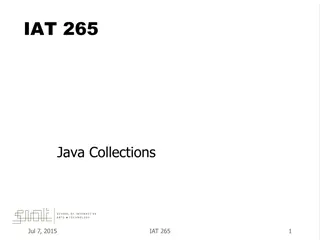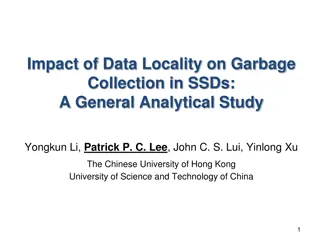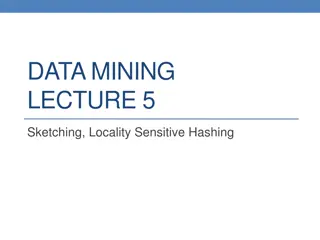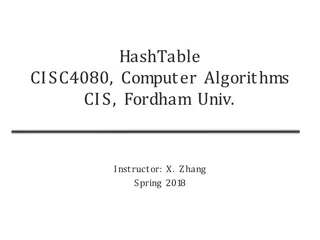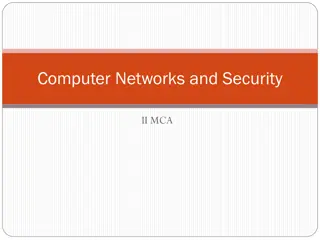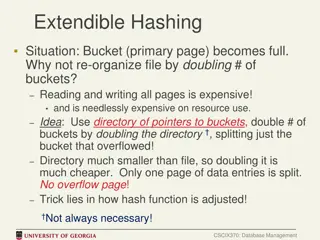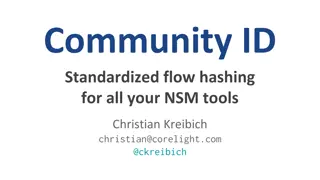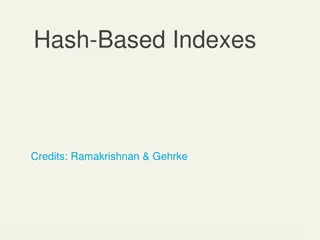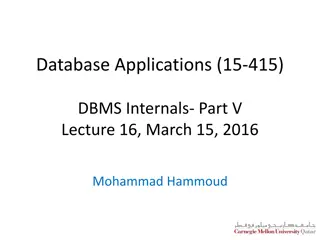Introduction to Min-Hashing and Locality Sensitive Hashing
Discover the concepts of Min-Hashing and Locality Sensitive Hashing as detailed in Rajaraman and Ullman's "Mining Massive Datasets" and Evimaria Terzi's Data Mining Course slides. Uncover the motivation behind finding duplicate and near-duplicate documents in large datasets, the challenges of document similarity representation, and the use of signatures to efficiently compare billions of documents.
Download Presentation

Please find below an Image/Link to download the presentation.
The content on the website is provided AS IS for your information and personal use only. It may not be sold, licensed, or shared on other websites without obtaining consent from the author.If you encounter any issues during the download, it is possible that the publisher has removed the file from their server.
You are allowed to download the files provided on this website for personal or commercial use, subject to the condition that they are used lawfully. All files are the property of their respective owners.
The content on the website is provided AS IS for your information and personal use only. It may not be sold, licensed, or shared on other websites without obtaining consent from the author.
E N D
Presentation Transcript
Advanced LabVIEW frclabviewtutorials.com/workshop
Using an Arduino for sensor input On the robo-RIO
Using an Arduino for sensor input Use Arduino to read sensors and stream data over connection to robo-RIO DIO/AIO Using Serial bus
Using an Arduino for sensor input DIO/AIO Code on Arduino to read/write pins Code on RoboRIO to read/write pins Code on destination to interpret result
Using an Arduino for sensor input Using Serial Bus Code on Arduino to open and transmit to port Code on RoboRIO to receive from port and interpret Code on RoboRIO to handle a loss of connection
Using an Arduino for sensor input Using Serial Bus Code on Arduino to open and transmit to port - setup #include <math.h> // largely from https://www.instructables.com/id/Simple-Arduino-and-HC-SR04-Example/ #define trigPin 13 #define echoPin 12 int order_of_mag; long duration; float distance; String message = "";
Using an Arduino for sensor input Using Serial Bus Code on Arduino to open and transmit to port - init void setup() { Serial.begin(9600); // must match baud rate on roboRIO open too. pinMode(trigPin, OUTPUT); pinMode(echoPin, INPUT); order_of_mag = 0; while(!Serial); // wait for it to be connected }
Using an Arduino for sensor input Using Serial Bus Code on Arduino to open and transmit to port read sensor void loop() { // write a 10 microsecond high pulse to the trigger - make sure it was low for at least 2 before digitalWrite(trigPin, LOW); delayMicroseconds(2); digitalWrite(trigPin, HIGH); delayMicroseconds(10); digitalWrite(trigPin, LOW); // measure time echoPin is HIGH in microS duration = pulseIn(echoPin, HIGH);
Using an Arduino for sensor input Using Serial Bus Code on Arduino to open and transmit to port scale to cm // average time to send and receive distance = (duration/2); // convert time to cm // s * ( 343 m/s) = s * 343 m // distance / 1000 * 353 = d m // distance * .0353 = d cm distance = distance * .0353;
Using an Arduino for sensor input Using Serial Bus Code on Arduino to open and transmit to port send // begin transmission Serial.print('^ ); // transmit distance Serial.print(distance); // end transmission Serial.println('$ ); // hold up 10 mS - don't need to overflow the buffer. delay(250);
Using an Arduino for sensor input Using Serial Bus Code on roboRIO to open port
Using an Arduino for sensor input Using Serial Bus Code on roboRIO to receive when available
Using an Arduino for sensor input Using Serial Bus Code on roboRIO to receive when available
Using an Arduino for sensor input Using Serial Bus Code on roboRIO to receive when available
Using an Arduino for sensor input Using Serial Bus Code on roboRIO to receive when available
Using an Arduino for sensor input Using Serial Bus Code on roboRIO to receive when available
Using an Arduino for sensor input Using Serial Bus Code on roboRIO to receive when available
Using an Arduino for sensor input Using Serial Bus Code on roboRIO to receive when available
Using an Arduino for sensor input Using Serial Bus Code on roboRIO to receive when available
Using an Arduino for sensor input Using Serial Bus Code on roboRIO to receive when available
Using an Arduino for sensor input Using Serial Bus Code on roboRIO to handle loss of connection
Using an Arduino for sensor input On the robo-RIO On the Dashboard
Using and Arduino with the Dashboard Driver station i/o Potentiometer for extra input (autonomous selection, shooter speed, etc.) Buttons/switches for additional control LEDs for indication Etc.
Using and Arduino with the Dashboard Customize the dashboard to read/write to Arduino Implement own serial interface (like with previous example on RoboRIO) or Use LINX library (https://www.labviewmakerhub.com/doku.php?id=libraries:linx:start)
Using and Arduino with the Dashboard Use LINX library Open connection Read/write to I/O Close connection
Using and Arduino with the Dashboard Use LINX library Open connection Read/write to I/O Close connection
PID Proportional
PID Proportional Constant multiplied by error (offset) The larger this is, the faster the robot approaches the setpoint (smaller rise time)
PID Proportional Constant multiplied by error (offset) The larger this is, the faster the robot approaches the setpoint (smaller rise time) Integral Constant multiplied by integral of all previous error values The larger this is, the less overshoot and settling time (less bounce)
PID Proportional Constant multiplied by error (offset) The larger this is, the faster the robot approaches the setpoint (smaller rise time) Integral Constant multiplied by integral of all previous error values The larger this is, the less overshoot and settling time (less bounce) Differential Used to eliminate steady state error (reducing offset after movement)
PID Proportional Constant multiplied by error (offset) The larger this is, the faster the robot approaches the setpoint (smaller rise time) Integral Constant multiplied by integral of all previous error values The larger this is, the less overshoot and settling time (less bounce) Differential Used to eliminate steady state error (reducing offset after movement)
PID Tuning
PID Tuning Several methods available Ziegler Nichols* Tyreus Luyben Cohen Coon str m-H gglund Manual Tuning*
PID Tuning Manuel Raise CP Until robot oscillates about setpoint Raise CD Until Robot stops bouncing Raise CI (and change the setpoint) until robot turns and hits the target point Ziegler-Nichols Raise CP Until robot oscillates (Value of CP becomes Ku) Measure the period of this oscillation (Time to complete 1 cycle becomes TU)
PID Tuning Manuel Raise CP Until robot oscillates about setpoint Raise CD Until Robot stops bouncing Raise CI (and change the setpoint) until robot turns and hits the target point Ziegler-Nichols Raise CP Until robot oscillates (Value of CP becomes Ku) Measure the period of this oscillation (Time to complete 1 cycle becomes TU)
PID Tuning Manuel Raise CP Until robot oscillates about setpoint Raise CD Until Robot stops bouncing Raise CI (and change the setpoint) until robot turns and hits the target point Ziegler-Nichols Raise CP Until robot oscillates (Value of CP becomes Ku) Measure the period of this oscillation (Time to complete 1 cycle becomes TU)
PID Demo
Functional Global Variable Quick Intro https://frclabviewtutorials.com/fgv/
FGV Functional Global Variable Code
Architectures State Machine
Architectures State Machine
Architectures State Machine
Architectures State Machine Producer-Consumer Parallel loops First creating data or instructions Other handling
Architectures State Machine Producer-Consumer Parallel loops Use either queue or fgv
Encoders Wiring (see notes for links) Rotational Encoders Fly wheel speed Drive distance Linear Encoders Linear actuator feedback Etc.


